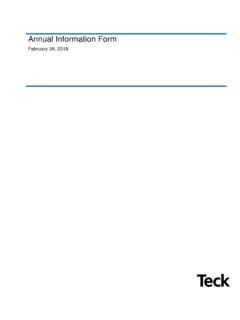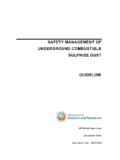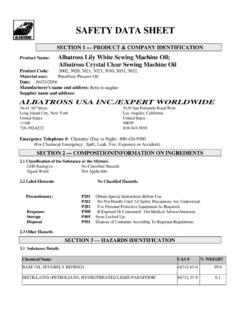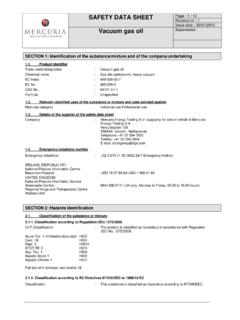Transcription of SULPHUR SAFETY DATA SHEET - Teck
1 May 25, 2015 SULPHUR Page 1 of 6 SULPHUR SAFETY data SHEET SECTION 1. IDENTIFICATION Product Identity: Molten SULPHUR . Trade Names and Synonyms: Sulfur, flowers of sulfur, brimstone. Manufacturer: Teck Metals Ltd. Trail Operations Trail, British Columbia V1R 4L8 Emergency Telephone: 250-364-4214 Supplier: Teck Metals Ltd. Trail Operations Trail, British Columbia V1R 4L8 Preparer: Teck Metals Ltd. Suite 3300 550 Burrard Street Vancouver, British Columbia V6C 0B3 Date of Last Revision: May 25, 2015. Date of Last Edit: May 25, 2015. Product Use: Raw material used in the manufacture of sulphuric acid and SULPHUR dioxide. Note: Although this SDS was prepared to address the hazards of molten SULPHUR , Teck Metals Ltd.
2 Recognizes that the product transforms into a solid rapidly upon cooling. Sections 2, 4, 5, 6, 7, 8, 9, and 11 address the hazards of the dry, as well as the molten, state of SULPHUR . SECTION 2. HAZARDS IDENTIFICATION CLASSIFICATION: Health Physical Environmental Acute Toxicity (Oral, Inhalation) Does not meet criteria Skin Corrosion/Irritation Does not meet criteria Eye Damage/Eye Irritation Does not meet criteria Respiratory or Skin Sensitization Does not meet criteria Mutagenicity Does not meet criteria Carcinogenicity Does not meet criteria Reproductive Toxicity Does not meet criteria Specific Target Organ Toxicity Acute Exposure Does not meet criteria Chronic Exposure Does not meet criteria Flammable Solids Category 2 Combustible Dust Category 1 Aquatic Toxicity Short Term/Long Term Does not meet criteria LABEL: Symbols.
3 Signal Word: WARNING Hazard Statements WARNING! Flammable Solid. May form combustible dust concentrations in air. Precautionary Statements: Keep away from heat, hot surfaces, sparks, open flames, and other ignition sources. No smoking. Ground and bond container and receiving equipment. Use explosion-proof equipment if dust cloud can occur. Wear protective gloves, clothing and eye protection (and face protection where appropriate). IN CASE OF FIRE: Use dry sand, etc. on small fires. Use water spray, fog or foam on larger fires. Emergency Overview: A bright yellow powder or an amber-to-yellow liquid. SULPHUR is relatively non-toxic and poses little immediate health hazard to the environment or emergency response personnel unless it is involved in a fire.
4 Both solid and liquid SULPHUR are combustible and generate large quantities of toxic and irritating SULPHUR dioxide gas on burning. Molten SULPHUR is hot enough to cause serious thermal burns to unprotected skin. Wear full protective clothing and positive pressure self-contained breathing apparatus in emergency situations involving burning SULPHUR . May 25, 2015 SULPHUR Page 2 of 6 Potential Health Effects: SULPHUR is relatively non-toxic to humans, causing only mild local irritation to the eyes, nose, throat and upper airways. However, under certain circumstances it may release toxic hydrogen sulphide and/or SULPHUR dioxide gas. SULPHUR is not listed as a carcinogen by OSHA, NTP, IARC or ACGIH (see Toxicological Information, Section 11).
5 Potential Environmental Effects: This product has the potential to pose ecological risks to organisms in both aquatic and terrestrial environments. Discharge of the product to soil and water should be prevented (see Ecological Information, Section 12). SECTION 3. COMPOSITION / INFORMATION ON INGREDIENTS HAZARDOUS COMPONENTS CAS Registry No. CONCENTRATION (% wgt/wgt) SULPHUR 7704-34-9 Note: See Section 8 for Occupational Exposure Guidelines. SECTION 4. FIRST AID MEASURES Eye Contact: Symptoms: Mild eye irritation, redness: Do not allow victim to rub eye(s). Let the eye(s) water naturally for a few minutes. If particle/dust does not dislodge, flush with lukewarm, gently flowing water for 5 minutes or until particle/dust is removed, while holding eyelid(s) open.
6 If irritation persists, obtain medical advice/attention. DO NOT attempt to manually remove anything stuck to the eye. Skin Contact: Symptoms: Mild irritation, dryness, thermal burn from molten SULPHUR . Dry SULPHUR : No health effects expected. If irritation does occur, flush with lukewarm, gently flowing water for 5 minutes. If irritation persists, obtain medical advice/attention. Molten SULPHUR : Flush contact area to solidify and cool but do not attempt to remove encrusted material or clothing. Cover burns and seek medical attention immediately. Inhalation: Symptoms: Coughing, irritation in heavy dust clouds. Remove source of contamination or move victim from exposure area to fresh air.
7 Obtain medical advice/attention if you are concerned or feel unwell. Ingestion: Symptoms: Throat dryness, SULPHUR taste. If swallowed, no specific intervention is indicated as this material is not likely to be hazardous by ingestion. However, if irritation or discomfort occurs or you are concerned, obtain medical advice/attention. SECTION 5. FIRE FIGHTING MEASURES Fire and Explosion Hazards: Both molten and solid forms are combustible and will ignite at high temperatures (>200 C), burning with a pale blue flame that may be difficult to see in daylight. SULPHUR dust suspended in air ignites easily and can cause explosions in confined spaces. SULPHUR dust clouds can be ignited by friction, static electricity, heat, sparks or flames.
8 Traces of hydrogen sulphide and SULPHUR vapor may present an explosion hazard if evolved into a confined space or enclosed space, particularly from molten SULPHUR . The LEL of hydrogen sulphide ( by volume in air) may be exceeded in enclosed spaces above molten SULPHUR . Extinguishing Media: Use water spray, fog or foam. Do not use direct water streams as the burning SULPHUR may float and further spread the fire. Sand, dry chemical or fine earth/finely crushed stone may be used for small fires. Steam or inert gases are excellent extinguishers for use in containers that can be tightly closed. Fire Fighting: Toxic fumes of SULPHUR dioxide will result from combustion.
9 Fire fighters must be fully-trained and wear full protective clothing including an approved, self-contained breathing apparatus which supplies a positive air pressure within a full face-piece mask. Do not spray water directly into containers of molten SULPHUR due to the danger of boil over. Also avoid spraying direct streams of water that may scatter burning SULPHUR and spread the fire or create SULPHUR dust clouds and cause an explosion. Evacuate non-essential personnel from the fire area immediately. For large fires, consider evacuation of an area downwind of fire if necessary. Fire will rekindle until mass has been cooled to below approximately 150 C. Cool surrounding area and containers until well after the fire is out to prevent re-ignition.
10 SECTION 6. ACCIDENTAL RELEASE MEASURES Procedures for Cleanup: Control source of spillage if possible to do so safely. Contain spill, isolate area, and deny entry to unauthorized personnel. Remove all potential ignition sources. Ventilate area. Prevent spread of liquid by diking or ditching and allowing material to cool and solidify. Clean up spilled material immediately, observing precautions in Section 8, Personal Protection and using methods which will minimize dust generation ( , dampen material and shovel or wet sweep using natural fiber brooms and aluminum shovels to prevent sparks). Return uncontaminated spilled material to the process if possible.
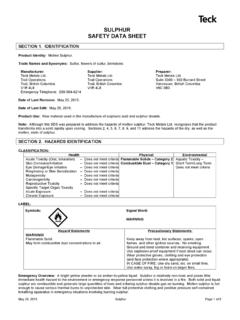
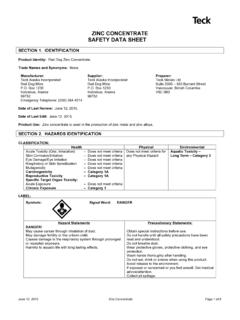
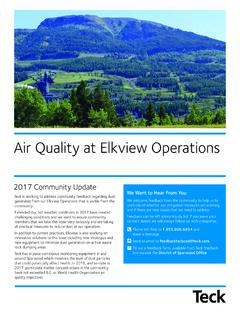
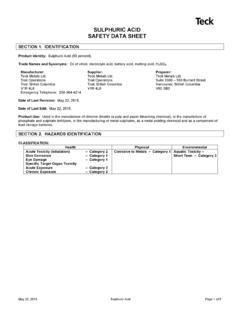
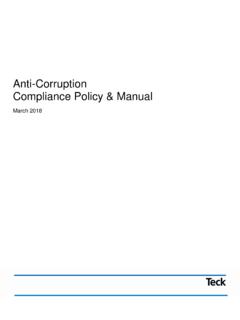
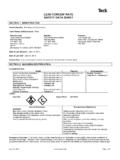
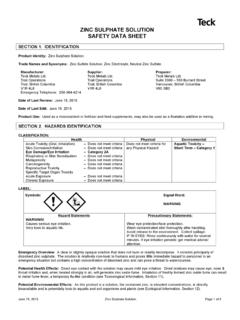
![Lead Metal SDS[2] - Teck](/cache/preview/e/2/d/9/e/e/c/7/thumb-e2d9eec71c9c8be922f6a8aefa2723ab.jpg)
